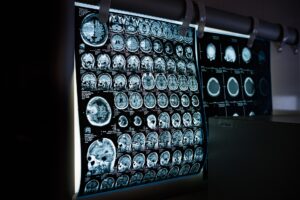
The Great News About Treating Epilepsy and Seizures
The ability of medical science to treat epilepsy and seizures has never been better than it is right now. We have learned so much about the various epilepsies and what actually causes the different types of seizures. New diagnostic methods and better medications have been developed in just the past several years. This advance in the understanding of epilepsy has led to ever more careful and precise diagnoses. Once the diagnosis is correctly made it points to the best medications to use. Anywhere from 75% to 90% of people with epilepsy will have it successfully treated with today’s treatments.
Welcome to the Neuroscience Research and Development Consultancy website. Have a question or a comment? Send it to us at: Comment@NeuroSciRandD.com
Treating Epilepsy and Seizures – The First Step
Once the diagnosis is made, the generally accepted guideline for treating epilepsy and seizures is to start the medication regimen using just one medication. Which medication to use as the first choice depends on the type of epilepsy and other considerations individual to each person. In a typical situation the epilepsy specialist will start that one medication at a medium dosage and slowly go up in dose until the seizures stop or side effects become a problem.
Treating Epilepsy and Seizures – #1 – After That First Step
So let’s assume that the dose of that first medication is gradually moved upward and at some point the seizures have stopped and any side effects of the medicine are minimal, or at least tolerable. Boom, goal reached, all is good, do no more.
Treating Epilepsy and Seizures – #2 – After That First Step
But now let’s assume that the dose of that first medication is gradually moved upward and at some point side effects start to become a problem. And let’s say that at the dosage where the side effects get in the way of going higher the seizures are only half controlled. The next step in the treatment plan gives the person with epilepsy and the doctor a fork in the road. One path forward is to stop the first medication and instead start a different medication. And then follow the same method with the second medication, start at a moderate dose and gradually go to higher doses as needed. The other path forward is to bring down the dose of that first medication so that the side effects are less and then add a second medication.
A Reader Asked:
If someone has seizures can’t you just give them one of the medicines to stop seizures? It doesn’t seem like it should be that complicated.
A good thought and a good question. All of neurological science would be happy if this were the case. Phenobarbital, the first medication for epilepsy, was introduced over 100 years ago. It would have been so wonderful if that were the one-and-only seizure medication we ever needed. While still in use, phenobarbital is helpful without problem side effects in only a few people who have seizures. In children it can cause problematic behavioral changes and can be toxic to nerve cells. It might even lower a child’s I.Q. (intelligence quotient). The changed behavior can create problems in school and in socializing. Epilepsy is not just one medical condition, it’s a set of medical syndromes that differ from each other. Newer medications for seizures have been developed that, for many people, work as well or better than phenobarbital with far fewer side effects.
But the reader’s question does not stop there. There’s a huge practical use and ethical debate in the medical world. Because, in the poorer countries (e.g., rural Africa) up to 85% of the 50 million people with epilepsy are unable to get any medicine. Compared to no treatment at all, phenobarbital is a good choice. It works and most, even poor, health systems can afford it. The World Health Organization, the International League Against Epilepsy, the Global Campaign Against Epilepsy, and the International Bureau for Epilepsy, promote phenobarbital use when nothing else is available. As a result, the value of phenobarbital is being reappraised. So, to some extent, the reader might be correct.
About the Medications Used for Treating Epilepsy and Seizures
There are many medications used to treat seizures and all of them work. In fact, all of them work just about as well as the rest of them. But, some medications do work better for some types of seizure, and the epileptologist will chose one that works for the person’s type of seizure and any individual needs. And beyond that, each person has a certain type of seizure and there are several medications that will work for that seizure type. So, how to choose which medication? In this situation, since they all work equally well, the choice depends on side effects and how easy the medication is to use. It also depends on whether the person is taking other medications that might be a problem with the seizure medication. And, of course, if they both work the same, whether one medication is considerably more expensive than another.
Seizure Types – These Seizures and Those Seizures
As one might guess at this point in the discussion, there are several different seizure types. The many types of seizures are often grouped together into four main categories. Adding to the confusion is that the names of some of these seizure types have recently been changed by the International League Against Epilepsy. We’ll explain that a bit more below.
- One group is the group called “Partial Seizures”. The name for this group has now been changed to “Focal Seizures”. This group includes seizures that start out as a focal seizure (affecting just one body part) but then spread to become “generalized seizures”, affecting the whole body.
- This next group has been called “Primarily Generalized Tonic-Clonic Seizures” for a long time. The new term for this group is “Bilateral Tonic-Clonic Seizures”.
- Then there is a third group called “Absence Seizures”.
- And finally there’s a group called “Atypical Absence” seizures. There are atypical absence seizures and then two further subtypes, “Atonic Absence Seizures” and “Myoclonic Absence Seizures”. In the past they were called petit mal seizures. Petit mal is French and the literal translation is “little evil”.
As we said above, different medications work better in certain types of seizures, so getting the correct diagnosis for the seizure type is important for the treatment to work.
Medications Used for Treating Partial Seizures
Four medications, carbamazepine, lamotrigine, levetiracetam, and oxcarbazepine are the best for partial or focal seizures, including partial or focal seizures that then become generalized seizures. One of these four is usually (but not always) the best starting medications for these specific types of seizures. But, here’s why everyone with seizures needs to work with a neurologist who’s an epilepsy expert. Carbamazepine and oxcarbazepine might worsen absence seizures or myoclonic seizures, and lamotrigine might make myoclonic seizures worse. So, a wrong diagnosis can put a person in more, rather than less, trouble.
Medications for Primarily Generalized Tonic-Clonic Seizures (New Name: Bilateral Tonic-Clonic Seizures)
There are three medications, lamotrigine, levetiracetam, and valproic acid or divalproex sodium, that are best for primarily generalized tonic-clonic seizures, now called bilateral tonic-clonic seizures. And, as mentioned above, lamotrigine might make myoclonic seizures worse. So, as always, care with making the right diagnosis is needed.
Medications for Absence Seizures
Ethosuximide and valproic acid or divalproex sodium are the ones best for absence seizures.
Medications for Atypical Absence, Atonic Absence, or Myoclonic Absence Seizures
And, finally, lamotrigine, levetiracetam, and valproic acid or divalproex sodium are best for atypical absence, atonic absence, and myoclonic absence seizures.
Well, All of That Seems Simple Enough After All
Well, not really that simple. Here’s the rub. Each of these several medications has its own unique effects, specific possible side effects, and the potential for being a problem with other medications a person might need to take. Plus, for any individual person, a medication might act differently, mainly having different side effects.
Seizures Medications and Pregnancy
Here an example of a problem of seizure medications interacting badly with other medications. Some epilepsy medicines can lower the amount of birth control pill hormone in a woman’s system. Thus, if one is not careful to adjust for this, she could have an unplanned pregnancy. And speaking of pregnancy, some of these medications are safer than others during pregnancy, and pregnancy itself can change the way the body handles these medications. The art and the science of medication use for epilepsy are both needed, and skill and experience are needed, in treating epilepsy and seizures. It actually is complicated!
Treating Epilepsy and Seizures – It’s Not All That Simple
Unless your doctor is a real expert, treating epilepsy and seizures can be difficult and complicated. And, as with any doctor, it helps a bit if the doctor has a good “bedside manner”. In fact, it’s interesting to realize that the doctors who are trained experts in neurology have their own doctors’ group, the American Academy of Neurology. But having additional expertise beyond this group, the doctors who know best about treating epilepsy and seizures have an even more specialized physicians’ group, the American Epilepsy Society.
A Group Making Patient Care Better – International League Against Epilepsy
There’s also a group that is a “people’s group”. It’s a group that has chapters and members all over the world. They provide quality information about epilepsy, support research and training on epilepsy, and work to improve patient care. The group is called the International League Against Epilepsy. They were started back in 1909 and the group now has over 100 local chapters in countries around the world. The International League Against Epilepsy is important because they help decide changes in the names of seizures and epilepsy and then let everyone know about these changes. There were some recent changes that we mentioned above and explain further below.
New Names for Seizure Types from the International League Against Epilepsy
The most recent new names for the seizure types were created about two years ago. The International League Against Epilepsy sent out new names for a couple of seizure types. For example, the seizures that used to be called “partial” seizures are now called “focal” seizures. And, the ones that were called “primarily generalized” seizures are now called “bilateral tonic-clonic” seizures. Here’s a link if you are interested for more details. It’s a 12-page paper, Fisher et al., Epilepsia, 58:531.
Cannabidiol
(If you’re one of our paid subscribers, you can also read our page on Cannabidiol for Epilepsy for more information on cannabidiol.
Cannabidiol is a natural product with no psychological effects. It’s found in the cannabis (marijuana) plant. THC (tetrahydrocannabinol) is the other and more well-known natural product in marijuana. THC is the one that gives marijuana its reputation for making one feel good and the one that provides users a “high”. Cannabidiol does not have these “psychological buzz” effects, Unfortunately, cannabidiol keeps popping up in the news as though it is the same as THC.
Dravet Syndrome
Dravet Syndrome is why cannabidiol is associated with epilepsy. Severe myoclonic epilepsy of infancy is the old name for Dravet Syndrome, since it begins when an infant is about six months old. The seizures in Dravet Syndrome are febrile seizures, that is, happening in hot temperatures or when the infant is feverish. Cannabidiol works well for treating Dravet Syndrome seizures. There is an approved, brand name medication, Epidiolex, that is a cannabidiol oral solution. The FDA approved it in mid-2018 for Dravet Syndrome (and for Lennox-Gastaut Syndrome). It is not known if Epidiolex works to treat other types of seizures or epilepsy.
Helpful Links:
Centers for Disease Control and Prevention on Treating Epilepsy
Epilepsy Foundation on Treating Seizures & Epilepsy
Mayo Clinic on Epilepsy Treatments
Johns Hopkins Medicine on Treatment for Epilepsy & Seizures



